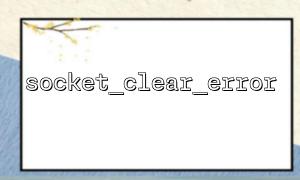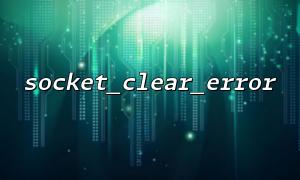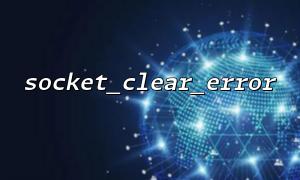When building a PHP-based chat server, socket programming is one of the core technologies. In network communication, errors occur from time to time, and correct error handling can ensure the stability and user experience of the server. PHP provides many socket-related functions, where the socket_clear_error() function plays an important role in error management. This article will explain in detail how to use socket_clear_error() in PHP chat servers to effectively control errors.
socket_clear_error() is a function in PHP that clears error status on the socket. During network communication, if the socket encounters an error, an error code will be set for subsequent query. By calling this function, the error status can be reset to avoid repeated processing of error messages or affecting subsequent operations.
Chat servers are usually in a long connection environment, socket connections will be frequently used. If the error status is not cleared in time, it will cause:
Result operation error
Error message accumulation affects performance
Unable to recover from the connection status
Therefore, using socket_clear_error() ensures that old errors are cleaned up before each operation, keeping the connection state accurate and clear.
Suppose we are implementing a simple PHP chat server, using socket to create a server port to listen to client requests:
<?php
$address = "m66.net";
$port = 12345;
$sock = socket_create(AF_INET, SOCK_STREAM, SOL_TCP);
socket_bind($sock, $address, $port);
socket_listen($sock);
while (true) {
$client = socket_accept($sock);
if ($client === false) {
echo "Accept failed: " . socket_strerror(socket_last_error()) . "\n";
socket_clear_error($sock); // Clear the server socket mistake
continue;
}
$input = socket_read($client, 1024);
if ($input === false) {
echo "Read failed: " . socket_strerror(socket_last_error($client)) . "\n";
socket_clear_error($client); // Clear the client socket mistake
socket_close($client);
continue;
}
$response = "Server received: " . trim($input);
socket_write($client, $response, strlen($response));
socket_close($client);
}
socket_close($sock);
?>
In the above code:
When socket_accept() fails, call socket_clear_error() to clear the error to prevent the legacy of the error status from affecting subsequent connections.
When reading client data, if an error occurs, socket_clear_error() is also called to clean up the error status of the client socket.
Error status management : socket_clear_error() is used to reset the socket's error mark to ensure that subsequent operations are not affected by historical errors.
A must-have for long-term connection environments : In long-running services such as chat servers, the error status needs to be cleaned in time to ensure stability.
Used with other error functions : often paired with socket_last_error() and socket_strerror() to detect, print and clear errors.
In PHP chat servers, network communication is complex and error-prone. The rational use of socket_clear_error() function can significantly improve the efficiency and accuracy of error handling and ensure the long-term and stable operation of the server. Combined with other socket error handling functions, developers can build robust and user-experience chat applications.













